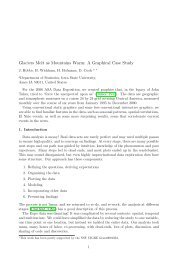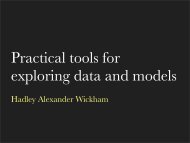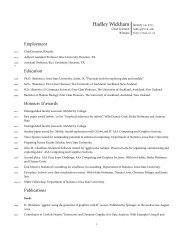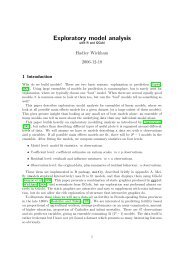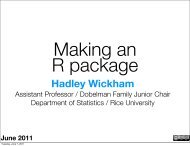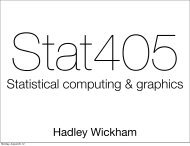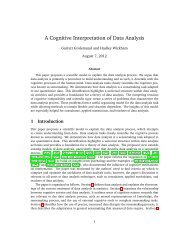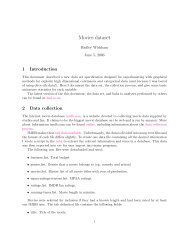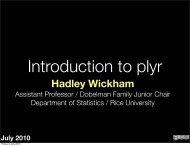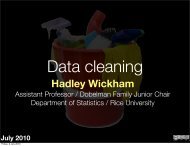Statistical inference for exploratory data analysis ... - Hadley Wickham
Statistical inference for exploratory data analysis ... - Hadley Wickham
Statistical inference for exploratory data analysis ... - Hadley Wickham
You also want an ePaper? Increase the reach of your titles
YUMPU automatically turns print PDFs into web optimized ePapers that Google loves.
<strong>Statistical</strong> <strong>inference</strong> <strong>for</strong> graphics 4363<br />
are given asymptotic guarantees of finding the ‘truth’ under certain conditions,<br />
or they are endowed with confidence bands that have asymptotically correct<br />
coverage. Coming from the opposite end, confirmatory statistics has become<br />
available to ever larger parts of statistics due to inferential methods that account<br />
<strong>for</strong> multiplicity, i.e. <strong>for</strong> simultaneous <strong>inference</strong> <strong>for</strong> large or even infinite numbers<br />
of parameters. Multiplicity problems will stalk any attempt to wrap confirmatory<br />
statistics around EDA and MD, including our attempt to come to grips with the<br />
inferential problems posed by visual discovery.<br />
The tools of confirmatory statistics have so far been applied only to features<br />
in <strong>data</strong> that have been captured algorithmically and quantitatively and our goal<br />
is there<strong>for</strong>e to extend confirmatory statistics to features in <strong>data</strong> that have been<br />
discovered visually, such as the surprise discovery of structure in a scatterplot<br />
(EDA), or the unanticipated discovery of model defects in residual plots (MD).<br />
Making this goal attainable requires a re-orientation of existing concepts while<br />
staying close to their original intent and purpose. It consists of identifying the<br />
analogues, or adapted meanings, of the concepts of (i) test statistics, (ii) tests,<br />
(iii) null distribution, and (iv) significance levels and p-values. Beyond a oneto-one<br />
mapping between the traditional and the proposed frameworks, <strong>inference</strong><br />
<strong>for</strong> visual discovery will also require considerations of multiplicity due to the<br />
open-ended nature of potential discoveries.<br />
To inject valid confirmatory <strong>inference</strong> into visual discovery, the practice needs<br />
to be supplemented with the simple device of duplicating each step on simulated<br />
<strong>data</strong>sets. In EDA, we draw <strong>data</strong>sets from simple generic null hypotheses; in MD,<br />
we draw them from the model under consideration. To establish full confirmatory<br />
validity, there is a need to follow rigorous protocols, reminiscent of those practised<br />
in clinical trials. This additional ef<strong>for</strong>t may not be too intrusive in the light<br />
of the inferential knowledge acquired, the sharpened intuitions and the greater<br />
clarity achieved.<br />
Inference <strong>for</strong> visual discovery has a pre-history dating back half a century.<br />
A precursor much ahead of its time, both <strong>for</strong> EDA and MD, is Scott et al. (1954).<br />
Using astronomical observations, they attempted to evaluate newly proposed<br />
spatial models <strong>for</strong> galaxy distributions (Neyman et al. 1953), by posing the<br />
following question: ‘If one actually distributed the cluster centres in space and<br />
then placed the galaxies in the clusters exactly as prescribed by the model,<br />
would the resulting picture on the photographic plate look anything like that<br />
on an actual plate…?’ In a Herculean ef<strong>for</strong>t, they proceeded to generate a<br />
synthetic 6 ◦ × 6 ◦ ‘plate’ by choosing reasonable parameter values <strong>for</strong> the model,<br />
sampling from it, adjusting <strong>for</strong> ‘limiting magnitude’ and ‘random ‘errors’ of<br />
counting’, and comparing the resulting ‘plate’ of about 2700 fictitious galaxies<br />
with a processed version of the actual plate, whose <strong>for</strong>eground objects had been<br />
eliminated. This was done at a time when sampling from a model involved<br />
working with published tables of random numbers, and plotting meant drawing<br />
by hand—the ef<strong>for</strong>t spent on a single instance of visual evidence is stunning!<br />
The hard work was of course done by ‘computers’, consisting of an office with<br />
three female assistants whose work was acknowledged as requiring ‘a tremendous<br />
amount of care and attention’. (The plots, real and synthetic, are reproduced in<br />
Brillinger’s 2005 Neyman lecture (Brillinger 2008), albeit with undue attributions<br />
to Neyman. Scott et al. (1954) acknowledge Neyman only ‘<strong>for</strong> his continued<br />
interest and <strong>for</strong> friendly discussions’.) Much later, when computer-generated<br />
Phil. Trans. R. Soc. A (2009)<br />
Downloaded from<br />
rsta.royalsocietypublishing.org on January 7, 2010



